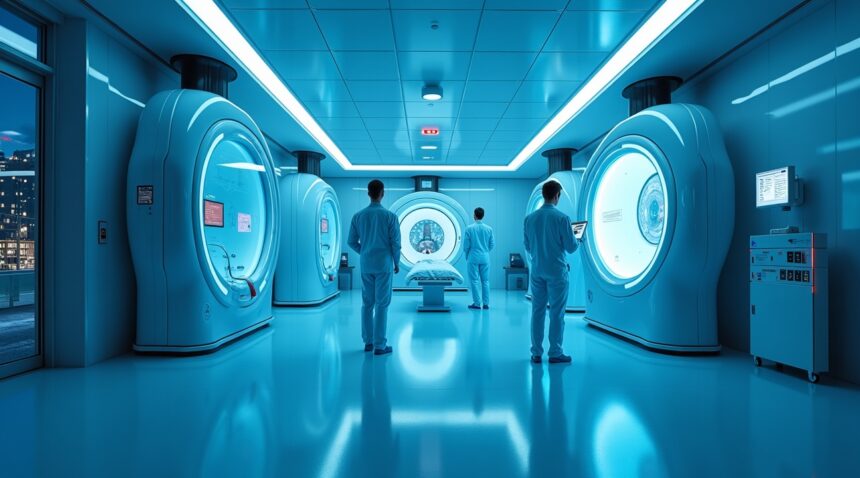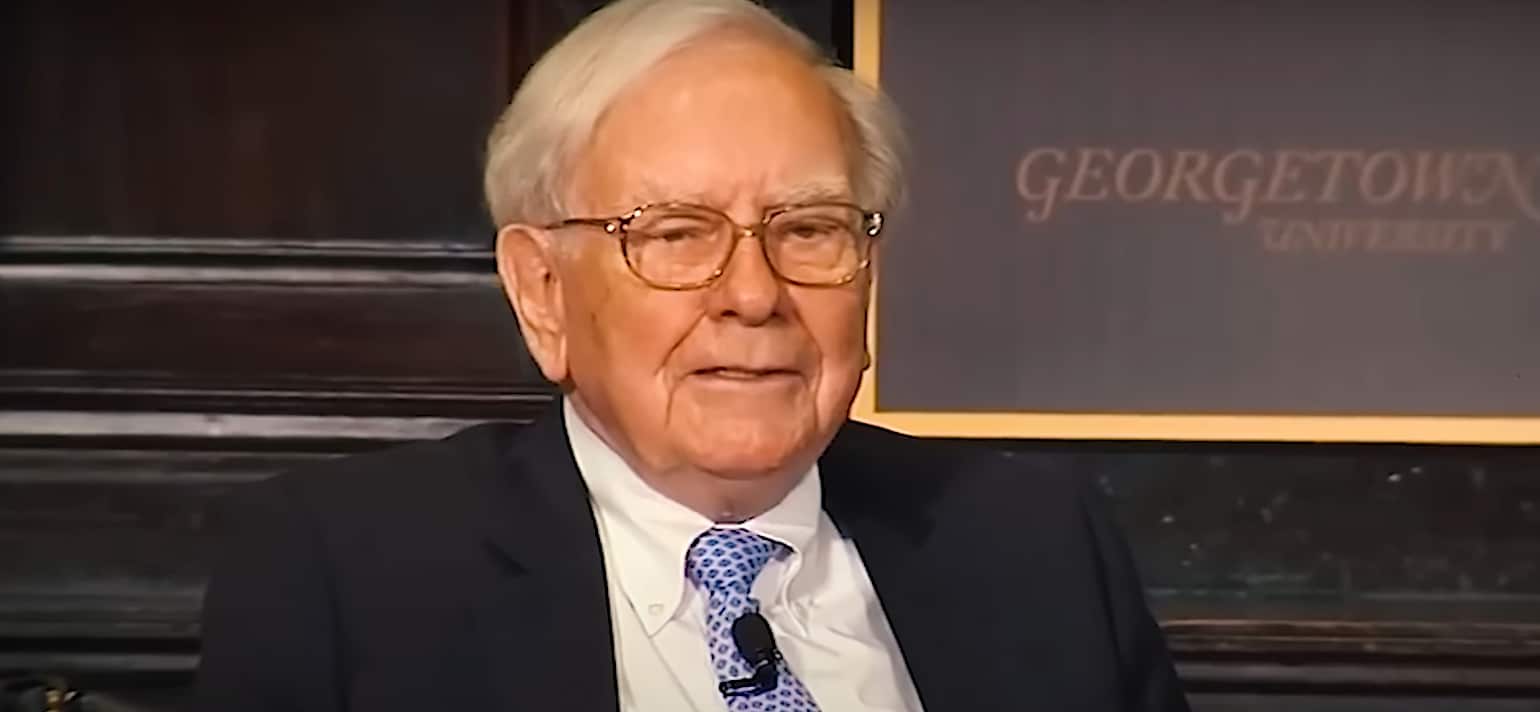Tomorrow Bio, a Berlin-based startup founded in 2020, has emerged as Europe’s first cryonics laboratory, offering full-body preservation services with the ambition of future human revival through developing technologies.
Key Takeaways
- Tomorrow Bio charges $200,000 for full-body cryopreservation and $80,000 for brain-only options, supported by a payment model with monthly fees of $55 and coverage via life insurance policies.
- The cryopreservation process includes fluid replacement with cryoprotectants and gradual cooling to -198°C within 24–48 hours of legal death.
- Scientific limitations persist; currently only small tissue samples have been revived, though no known laws of biology rule out future revival of preserved humans.
- An independent foundation ensures sustainability by investing cryopreservation dues to cover indefinite storage through systems not reliant on external power sources.
- Tomorrow Bio has expanded into the U.S. with facilities in major cities and targets tech-savvy individuals in the 30–40 age range who view it as an investment in potential life extension.
Innovating Cryonics in Europe and Beyond
Tomorrow Bio stands apart from traditional American cryonics organizations by combining European scientific standards with a modern, transparent approach. Their full-body and neuro cryopreservation services are designed to appeal to both tech-driven individuals and families seeking comprehensive solutions, including the preservation of beloved pets.
The process begins immediately after a legal death declaration. Trained cryonics teams are deployed to the scene, aiming to preserve cellular integrity by initiating procedures within hours. The team replaces blood and other fluids with cryoprotectant compounds—biologically engineered to mimic antifreeze—that prevent damaging ice crystal formation in living tissue.
Storage and Preservation Techniques
Gradual cooling follows the cryoprotection step, reducing the body’s temperature to -198°C, at which point it is stored in specialized containers filled with liquid nitrogen called dewars. These dewars keep the body in a thermodynamically stable state for an indefinite period, awaiting technological advancements that may one day enable revival.
Business Model & Financial Strategy
A key challenge in cryonics has long been financial sustainability. Tomorrow Bio addresses this through a dual-fee model: a $55 monthly membership builds member equity in the process, and final costs are often handled through designated life insurance plans. Preservation payments are routed into the Tomorrow Patient Foundation, which invests conservatively to ensure long-term funding for ongoing care.
- Storage costs are covered indefinitely thanks to energy-independent systems and a strategic investment model.
- Storage sites maintain high operational standards, including full backup systems and trained cryonics response personnel in every location.
Science, Skepticism, and Hope
Although no human has yet been revived from cryonic preservation, Tomorrow Bio acknowledges current scientific restrictions openly. Revival has only been achieved with small tissues the size of a frog’s heart; full recovery of complex organisms remains speculative. However, the company maintains that advancing fields like nanotechnology and regenerative medicine could overcome these hurdles in the future.
- Critics worry about false hope and the ethics of reviving individuals in unknown future societies.
- Supporters argue that cryonics offers the only real option for preserving someone after death pending advancements in medical science.
Expanding Markets and Psychological Appeal
Tomorrow Bio’s presence in the U.S. reflects a growing international interest in cryonics. Locations in New York, California, and Florida enhance their logistical ability to respond quickly, a critical factor in preserving tissue viability.
The profile of a typical client often includes professionals in tech fields, entrepreneurs, and science enthusiasts—individuals willing to bet on future technology. Cryopreserving pets is also gaining traction, offering emotional continuity for families and reinforcing the company’s holistic family-focused services.
A Transparent and Strategic Approach
Tomorrow Bio emphasizes clear communication about both the possibilities and limitations of cryonics. Educational resources and community engagement distinguish the company from competitors that might sensationalize their offerings. By collaborating with academic institutions and research facilities, Tomorrow Bio continues to improve upon preservation protocols and explore the philosophical implications of revival, identity, and life extension.
As public interest in radical longevity grows, Tomorrow Bio positions itself at the crossroads of current biostasis technology and speculative medical resurrection. While doubts persist, their transparent business model, strong research ties, and international growth suggest that a growing number of people are willing to invest in what might become the next major leap in human health care.
This Berlin Startup Charges $200,000 to Freeze Your Body Until Science Can Bring You Back
Tomorrow Bio represents Europe’s groundbreaking entry into cryopreservation technology, positioning itself as the continent’s first cryonics laboratory. Founded in 2020 by Dr. Emil Kendziorra, a former cancer researcher, and engineer Fernando Azevedo Pinheiro, this Berlin-based startup has quickly established itself as a pioneer in what many consider the ultimate life extension service.
The company’s ambitious mission statement reflects a bold vision: “to build a world where people can choose how long they want to live – independent of where they are, who they are, and their financial resources.” This philosophy drives their operations across Europe and, as of July 2024, their expansion into the United States with facilities in New York, California, and Florida.
Current statistics demonstrate growing consumer confidence in cryopreservation technology. As of May 2025, Tomorrow Bio has successfully cryopreserved 20 people and 10 pets, while maintaining a robust membership base of over 650 paying customers awaiting future preservation services. These numbers indicate substantial market interest in life extension technologies, similar to how artificial intelligence continues advancing across various sectors.
Target Demographics and Market Positioning
Tomorrow Bio’s customer base reveals fascinating patterns about early adopters of cryopreservation technology. The typical client profile includes individuals between 30 and 40 years old who work primarily in technology sectors and are predominantly male. This demographic alignment suggests that those most familiar with emerging technologies feel most comfortable investing in experimental life extension services.
The $200,000 price point positions Tomorrow Bio’s services as premium offerings within the cryopreservation market. While this investment level might seem substantial, it reflects the complex scientific processes, specialized equipment, and long-term storage commitments required for cryogenic preservation. The company’s European operations provide an alternative to established American cryonics facilities, offering geographic convenience for international customers.
Tomorrow Bio’s rapid expansion from its Berlin headquarters to multiple U.S. locations demonstrates the growing global demand for cryopreservation services. Their success in accumulating hundreds of members before achieving widespread media attention suggests strong word-of-mouth marketing within tech communities. The inclusion of pet preservation services also indicates the company’s understanding that clients often view cryopreservation as a family decision rather than an individual choice.
The startup’s combination of scientific expertise from cancer research and engineering backgrounds provides credibility in a field often viewed with skepticism. Dr. Kendziorra’s medical research experience brings clinical understanding to the preservation process, while Pinheiro’s engineering skills address the technical challenges of maintaining ultra-low temperature storage systems over extended periods.
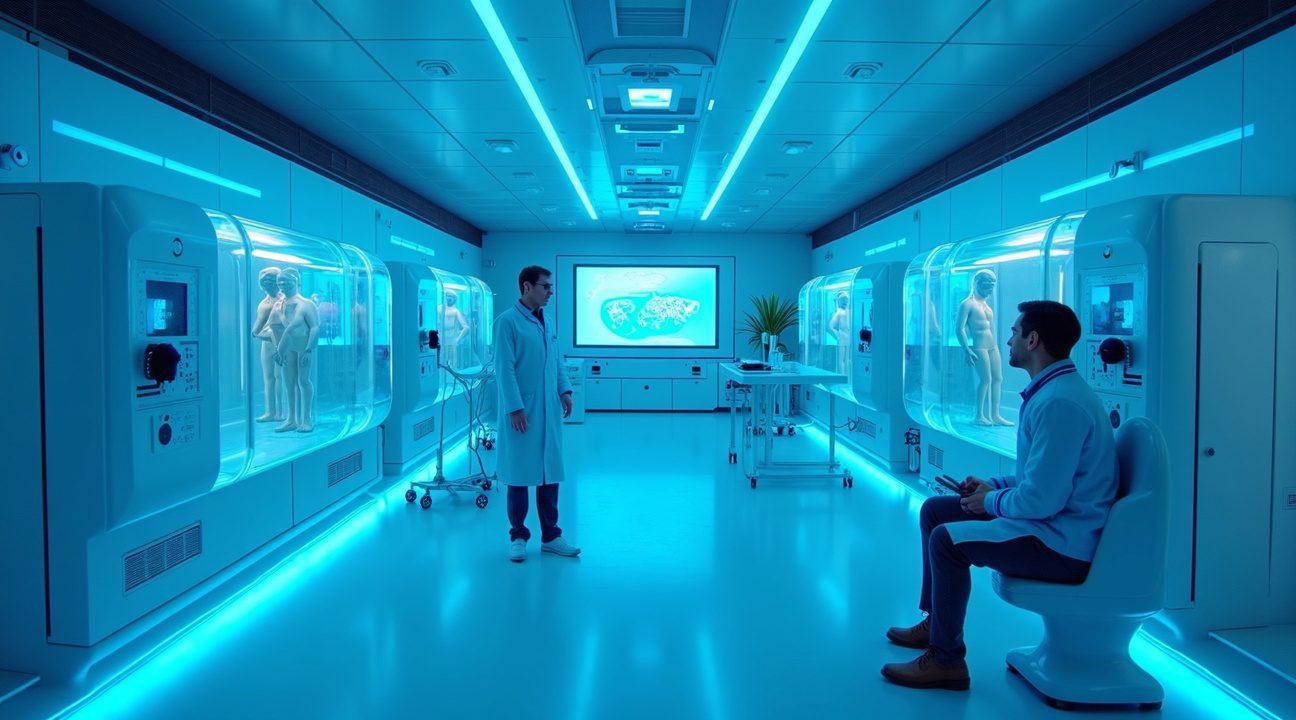
How the $200,000 Two-Part Payment System Works
Tomorrow Bio has structured its cryopreservation services around a two-part payment model that makes the technology more accessible than traditional lump-sum approaches. This system splits the financial commitment between ongoing membership costs and the final preservation fee.
Membership Structure and Monthly Costs
The first component involves a membership fee that ensures immediate access to cryopreservation services. Members can choose from several payment options:
- Monthly payments of $55 ($50/month in Europe)
- Annual payments of $550 (approximately €500 in Europe)
- Lifetime membership for a one-time payment of $9,999
This membership fee provides 24/7 availability of specialized medical teams and maintains critical equipment including ambulances and heart-lung machines. I consider this ongoing investment essential because cryopreservation requires immediate response capabilities that must be maintained continuously.
The membership ensures that when the time comes, advanced medical technology and trained personnel will be ready to begin the preservation process without delay. Time becomes the most critical factor in successful cryopreservation, making this standby service invaluable.
Cryopreservation and Final Payment
The final payment occurs at the time of death and covers the actual cryopreservation procedure. Tomorrow Bio offers two main options:
- Full-body preservation for $200,000 USD (€200,000)
- Brain-only preservation for $80,000 USD (€75,000)
These fees encompass the complete process from initial response through long-term storage.
Most members finance this final cost through term life insurance policies rather than saving the full amount. Financial analysis conducted by Tomorrow Bio reveals that the price difference between enrolling at age 30 versus age 50 remains less than 1% when insurance premiums are maintained until age 70. This finding suggests that age doesn’t significantly impact the total cost when using insurance as the funding mechanism.
The $200,000 fee covers an extensive range of services that begin the moment death is declared. Medical teams dispatch immediately to the location, then wait for legal death to be officially pronounced before beginning the preservation process. The procedure itself involves rapidly cooling the body and replacing blood with cryoprotective solutions to prevent ice crystal formation.
Transportation to Tomorrow Bio’s Switzerland facility is included, along with the complex process of gradually cooling the body to -196°C using liquid nitrogen. Long-term storage and care represent ongoing costs that the company commits to maintaining indefinitely, regardless of how future technological advances might change the landscape.
Strategic Financial Planning
I find this payment structure particularly strategic because it addresses the primary financial barrier that prevents many people from considering cryopreservation. Rather than requiring immediate access to $200,000, the system allows individuals to build this capacity over time through affordable insurance premiums while maintaining immediate access to services through membership fees.
The insurance-based approach also provides flexibility for members who might face changing financial circumstances. Term life insurance policies can often be adjusted or converted as needed, providing more adaptability than a large upfront investment would offer.
Tomorrow Bio’s comprehensive fee structure eliminates hidden costs that might surprise members or their families during an already difficult time. The company has designed this system to provide complete transparency about what the investment covers, from initial emergency response through potentially decades of storage and maintenance.

From Death to Deep Freeze: The Complete Preservation Process
The preservation journey starts the moment legal death is declared, setting in motion a carefully orchestrated sequence that must unfold with precision timing. Tomorrow Bio maintains standby teams strategically positioned across Berlin, Amsterdam, and Zurich to ensure rapid response when needed.
Medical professionals immediately begin resuscitative measures including chest compressions and oxygen supply to maintain cellular viability during the initial transition period. These efforts aren’t designed to revive the patient but rather to preserve tissue integrity while preparations for the next phase begin. Teams simultaneously initiate rapid cooling protocols using ice and water to slow decomposition processes that would otherwise compromise cellular structures.
The Critical Fluid Replacement Phase
Once initial cooling stabilizes the body temperature, technicians begin the most complex part of the process: complete fluid replacement. Every drop of blood and bodily fluid gets replaced with a specialized cryoprotectant solution that functions similarly to biological antifreeze. This substance prevents devastating ice crystal formation that would otherwise shred cellular membranes and tissues during the freezing process.
The cryoprotectant infusion requires careful monitoring as it circulates through the vascular system, ensuring complete saturation of all organs and tissues. Medical teams use specially equipped ambulances positioned throughout Europe to transport the prepared body to the European Biostasis Foundation facility in Rafz, Switzerland. These vehicles maintain optimal conditions during transport, preserving the delicate work already completed.
At the Swiss facility, the body enters the final preservation phase within massive vacuum-insulated steel containers called dewars. These towering structures reach 3.2 meters in height and represent the culmination of decades of cryogenic engineering. The controlled cooling process begins gradually, bringing the body’s temperature down to -198 degrees Celsius over a 10-day period.
This extended cooling timeline prevents thermal shock that could damage preserved tissues. The final temperature matches that of liquid nitrogen, creating an environment where biological processes essentially cease. What makes this system particularly appealing from a business perspective is its independence from electrical power. The vacuum insulation maintains temperature through passive physics rather than energy-hungry refrigeration systems, making long-term storage economically sustainable.
The dewars themselves function as biological time machines, suspending their contents in a state where cellular decay stops completely. Multiple bodies can be stored within each container, maximizing efficiency while maintaining individual preservation quality. Facility staff monitor these containers continuously, though the passive cooling system requires minimal intervention once properly established.
Staff members regularly check nitrogen levels and container integrity, but the fundamental preservation doesn’t depend on active maintenance systems that could fail. This design philosophy addresses one of the biggest concerns potential clients express about cryogenic preservation:
- What happens during power outages?
- What happens during facility emergencies?
The answer lies in the elegant simplicity of passive cooling systems that continue functioning regardless of external circumstances.
The entire process from death to final preservation typically completes within 24 to 48 hours, depending on transportation logistics and preparation complexity. Tomorrow Bio’s distributed team approach minimizes delays that could compromise preservation quality. Each minute matters during the initial phases, as cellular damage accumulates rapidly without proper intervention.
Temperature monitoring systems track the gradual cooling process throughout the 10-day period, ensuring optimal preservation conditions. The facility maintains detailed records for each preserved individual, documenting everything from initial response times to final storage parameters. These records could prove crucial if and when revival technologies become available, providing medical teams with comprehensive information about preservation quality and procedures used.
The process represents a fascinating intersection of cutting-edge technology and fundamental physics principles. While the science behind revival remains theoretical, the preservation techniques draw from established medical and industrial practices adapted for this unique application. Each step builds upon proven cryogenic storage methods used in research laboratories and medical facilities worldwide.
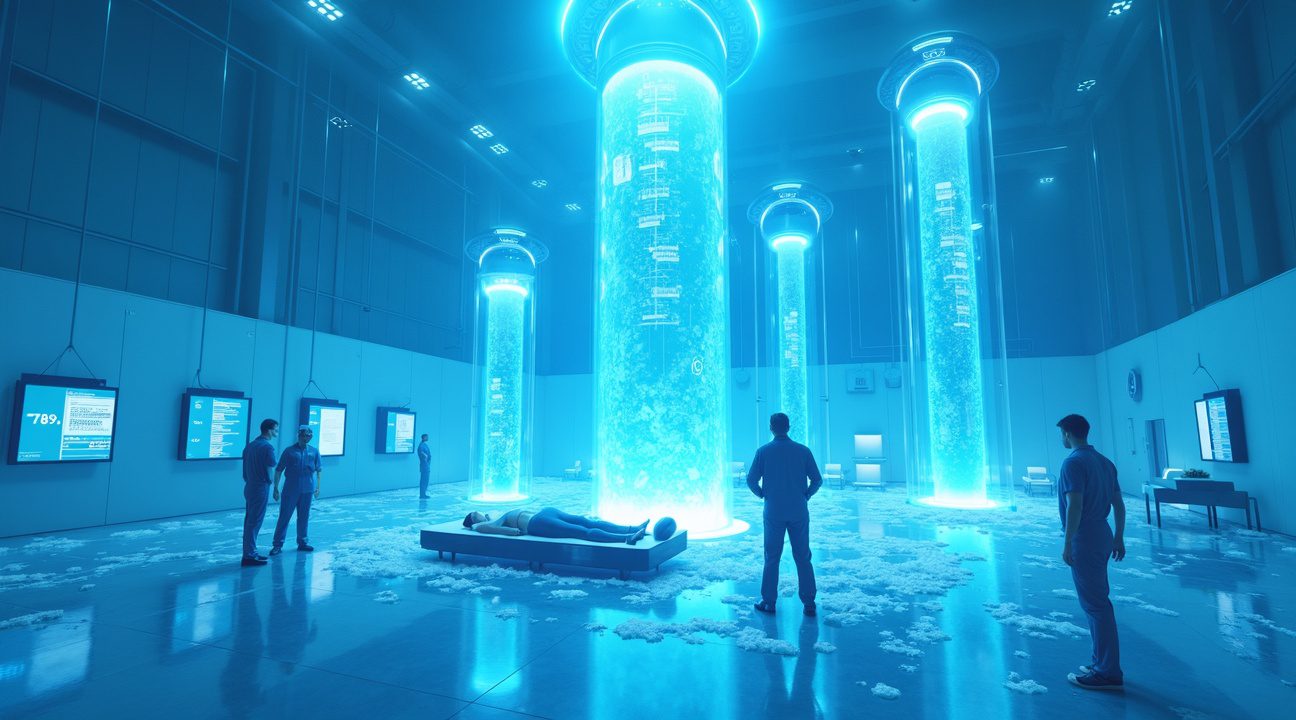
The Science Behind Cryopreservation and Current Revival Limitations
I find the science of cryopreservation fascinating in its simplicity and complexity. The process involves cooling the human body to extremely low temperatures—approximately -198 degrees Celsius or -328 degrees Fahrenheit—using liquid nitrogen, which effectively halts all biological activity. Before the deep freezing begins, technicians treat the body with cryoprotectant solutions to prevent the formation of damaging ice crystals that could destroy cellular structures.
This carefully controlled process creates a state called biostasis, where all biological functions become completely paused. Think of it as pressing the ultimate pause button on life itself. The body remains in this suspended state indefinitely, with the hope that future medical advances will enable revival and treatment of whatever condition led to the person’s initial death.
Current Scientific Achievements
I’ve observed encouraging progress in smaller-scale cryopreservation efforts. Researchers have successfully reanimated various cryopreserved biological materials, including embryos, sperm, skin, and even a rabbit kidney that resumed full function after warming. A 2016 study demonstrated that a rabbit’s brain retained almost perfect structure following cryopreservation, suggesting that complex neural networks can survive the freezing process.
These achievements represent significant steps forward, yet they also highlight our current limitations. Artificial intelligence and advanced medical technologies continue evolving rapidly, potentially offering solutions to revival challenges we can’t yet solve.
The Reality Check
Despite these advances, one co-founder pointed out a sobering reality: “the magic limit for the life-sustaining cryopreservation of tissue structures is a frog’s heart the size of a fingernail, and this has not changed since the 1970s.” This limitation illustrates the enormous gap between preserving small tissue samples and successfully reviving an entire human body.
Current science doesn’t allow for human revival after cryopreservation, but I find it important to note there’s no known biological reason that would make it permanently unachievable. The challenge lies in developing technology capable of repairing cellular damage, reversing the original cause of death, and restarting complex biological systems simultaneously. Future technological breakthroughs may eventually overcome these obstacles, though the timeline remains completely uncertain.
The procedure essentially represents a calculated bet on future medical capabilities, with participants hoping that tomorrow’s science will solve today’s impossibilities.

How Tomorrow Bio Ensures Financial Sustainability for Indefinite Storage
Tomorrow Bio addresses one of the most critical concerns in cryopreservation: how to maintain financial stability across potentially centuries of storage. I find their approach particularly compelling because it tackles the fundamental challenge that has historically plagued similar ventures.
The Tomorrow Patient Foundation Model
The company channels the majority of membership and cryopreservation fees directly into the Tomorrow Patient Foundation (TPF), a specialized patient care trust. This foundation operates independently from Tomorrow Bio’s day-to-day business operations, creating a protective barrier around the funds essential for long-term preservation. The TPF invests these resources exclusively in extremely low-risk portfolios designed to generate returns of 1-2% annually above inflation rates.
This conservative investment strategy might seem modest compared to aggressive growth portfolios, but it serves a crucial purpose. The steady returns provide sufficient income to cover ongoing maintenance expenses, particularly the continuous supply of liquid nitrogen required for storage. Such an approach prioritizes stability over spectacular growth, recognizing that consistency matters more than performance when dealing with indefinite timeframes.
Energy-Independent Storage Solutions
Tomorrow Bio’s storage infrastructure relies on liquid nitrogen rather than electrical power systems, creating significant advantages for long-term sustainability. This design choice eliminates dependency on power grids and protects against electrical outages that could compromise preservation quality. The containers maintain their required temperatures through the natural properties of liquid nitrogen, making the system virtually self-sustaining once established.
The economic implications of this approach extend beyond mere cost savings. Energy independence reduces operational complexity and minimizes variables that could threaten financial sustainability over extended periods. When storage facilities don’t require constant electrical input, maintenance costs become more predictable and manageable through the foundation’s conservative investment returns.
This financial framework represents a significant evolution in how cryopreservation companies approach long-term viability. Rather than relying on continued business growth or external funding, Tomorrow Bio has created a self-perpetuating system designed to function independently for indefinite periods. The combination of dedicated trust management, conservative investment strategies, and energy-independent storage technology creates what appears to be a genuinely sustainable model for preserving human bodies across potentially centuries of storage.
Similar innovations in artificial intelligence paving the way for the future continue to reshape how we think about long-term planning and resource management across various industries.
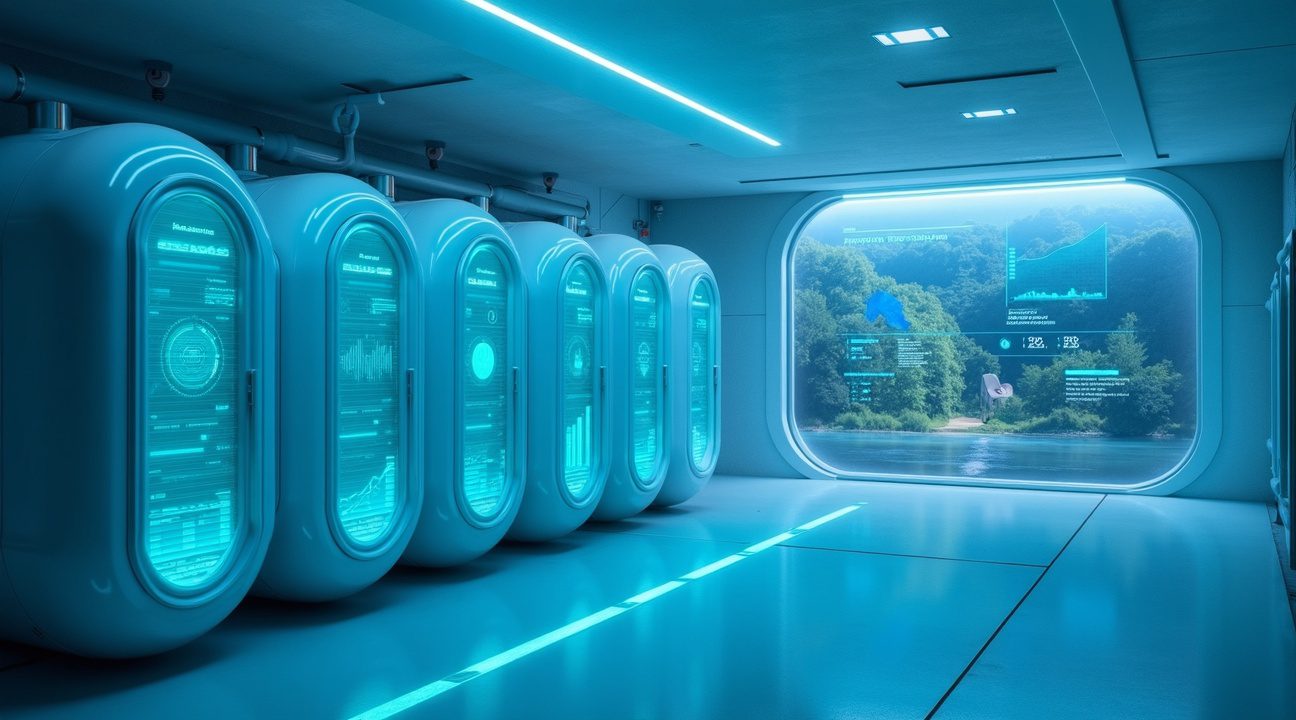
Debunking Myths and Understanding the Reality of Cryopreservation
I’ve encountered countless misconceptions about cryopreservation during my research into this fascinating field. Popular culture has created a cloud of misinformation that often obscures the scientific reality behind this emerging technology.
Separating Fact from Fiction
The most persistent myth involves Walt Disney’s alleged preservation after his death. BBC confirmed in 2019 that no evidence supports this widespread rumor—Disney was cremated, not cryopreserved. This false narrative has unfortunately shaped public perception for decades, creating unrealistic expectations about the process.
Another critical misunderstanding centers on the preservation method itself. Many people assume cryopreservation equals standard freezing, but I can assure you the processes are fundamentally different. Conventional freezing creates ice crystals that destroy cellular structures, making revival impossible. Tomorrow Bio employs sophisticated medical-grade cryoprotectant solutions that prevent ice crystal formation entirely. These solutions work by replacing water in cells and tissues, allowing preservation at extremely low temperatures without cellular damage.
Currently, approximately 500 individuals worldwide have undergone cryopreservation through various companies. While this number might seem small, it represents growing confidence in the technology’s potential. However, even Tomorrow Bio’s co-founders maintain realistic expectations about outcomes. Emil Kendziorra stated: “I think there’s a good chance for it, but do I know for sure? Absolutely not.”
This honest assessment reflects the scientific approach these companies take. They don’t promise guaranteed revival—they offer preservation with the hope that future medical advances will make restoration possible. Artificial intelligence and other technological breakthroughs could potentially play crucial roles in developing revival techniques.
Strategic Considerations: Timing and Cost
The financial structure also reveals important strategic considerations. Between ages 30 and 50, insurance cost differences remain minimal—less than 1% variation. Early enrollment provides significant advantages beyond cost savings:
- Eligibility is more easily secured when you’re healthy.
- Lower premiums can be locked in earlier in life.
- Advance preparation increases preservation success rates.
I’ve observed that many people postpone enrollment thinking they have unlimited time to decide. This procrastination can prove costly, both financially and practically. Health conditions that develop over time might make someone ineligible for preservation. Early sign-up eliminates these risks while locking in favorable insurance rates.
The Importance of Rapid Response
The preservation process itself requires immediate response after death. Tomorrow Bio maintains standby teams ready to begin preservation procedures within minutes. Delays can significantly impact cellular integrity and reduce revival chances. Members who enroll early receive detailed preparation instructions and emergency contact protocols, ensuring optimal preservation conditions.
Is Cryopreservation Pseudoscience?
Critics often dismiss cryopreservation as pseudoscience, but the underlying biology shows promise. Research demonstrates that certain organisms can survive extreme cold through natural cryoprotection mechanisms. Scientists have successfully preserved and revived simple organisms, providing proof of concept for the technology.
The $200,000 price tag might seem steep, but it reflects the complex infrastructure required. Storage facilities must maintain consistent temperatures for potentially decades or centuries. Monitoring equipment, backup systems, and staff expertise all contribute to operational costs. When compared to other end-of-life expenses or life extension investments, the pricing becomes more reasonable.
The Future of Cryopreservation
Modern cryopreservation represents humanity’s first serious attempt at defeating biological death through technology. While revival remains unproven, the scientific foundation continues strengthening. Future technological advances may eventually make what seems impossible today routine medical practice.
Understanding these realities helps potential candidates make informed decisions about cryopreservation. The technology offers hope without guarantees, requiring careful consideration of personal values, financial resources, and risk tolerance.
https://www.youtube.com/watch?v=ViBMR7uRnjQ
Sources:
Tomorrow.bio – Leading Human Cryopreservation Services
This Berlin company is pioneering a chilling new €50-a-month cryogenics subscription (Fortune Europe)
German startup is freezing dead bodies to revive them in future for Rs 1.8 crore (Hindustan Times)
This German Start-Up Will Cryogenically Freeze Your Body for $200K (Tribune.com.pk)
Not just science fiction: Tomorrow.Bio has preserved 20 people and 10 pets for future revival (Tech.eu)

